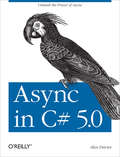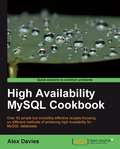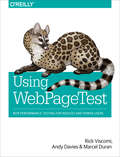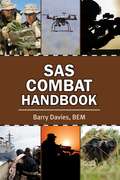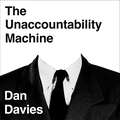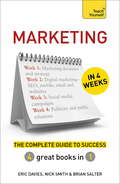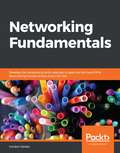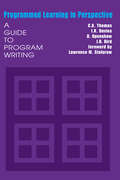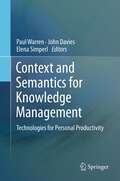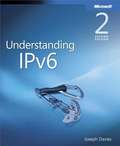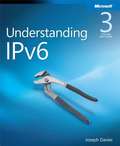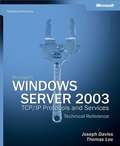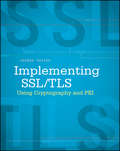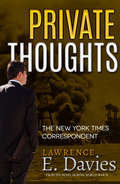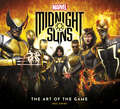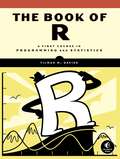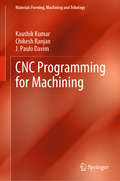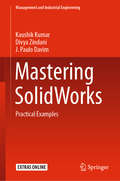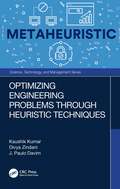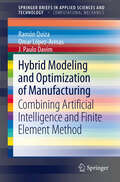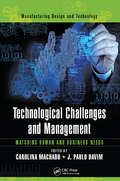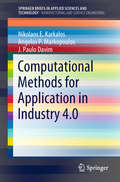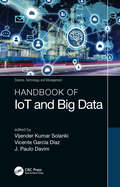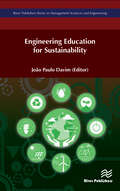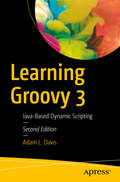- Table View
- List View
Async in C# 5.0: Unleash the Power of Async
by Alex DaviesThis book is for experienced C# developers that need to get a quick yet in depth look at what the new feature async in C# 5.0 means for their current and future projects.
High Availability MySQL Cookbook
by Alex DaviesThis book uses the approach of a cookbook. Each recipe provides the reader with easy step-by-step descriptions of the actions necessary to accomplish a specific task. It is designed to present what often appear as extremely complicated techniques as a series of simple-to-follow recipes, allowing readers to achieve high uptimes on their MySQL servers. This book is targeted at system administrators or database administrators who have basic familiarity with Linux, the shell, and MySQL. The typical user will be able to get MySQL installed and working, but needs practical guidance to make it highly available.
Using WebPageTest
by Andy Davies Marcel Duran Rick ViscomiLearn basic and advanced uses of WebPagetest, the performance measurement tool for optimizing websites. This practical guide shows users new to this tool how run tests and interpret results, and helps experienced users gain a better and more thorough understanding of hidden features in WebPagetest that make testing easier.Written by WebPagetest power users and performance experts, this book will help web developers and frontend engineers solve the problem of slow sites. Topics include:Basic test setup--shows beginners how to get meaningful resultsAdvanced test setup--provides another level of technical depth by explaining features not thoroughly documented at webpagetest.orgAnalysis of results--helps you understand of how to interpret test resultsPrivate instance setup--teaches power users the intricacies of the webpagetest private instance and how it worksAPI and external tools--provides a detailed reference for the API and demonstrates tools already using the API to extend WebPagetest
SAS Combat Handbook
by Barry DaviesAn SAS soldier explains the battle history of this prestigious military service, while teaching how you can defend yourself in both hand-to-hand and military combat. Seventy years after its inception, the Special Air Service (SAS) is recognized by many as one of the most decorated military forces in the world. Their soldiers do battle on a daily basis, taking actions that are normally swift, very hard hitting, and extremely secretive. They will go--willingly--deep behind enemy lines, taking on incredible odds and risking their lives in the hope of rescuing others. In the SAS Combat Handbook, you will be informed on all aspects of SAS operations. With never-before-seen photographs of these heroes in action and untold stories of individual acts of bravery, you will be taught the key combat methods that have made this military group exactly what they are: elite. Included are training tips that will teach you about various military tactics, such as: The art of cover and remaining hidden behind enemy lines The keys to covert insertion and extraction operations Counterterrorism skills, including building entry, ambush, and sniping Fire battles on land, in the air, or at sea And so much more From the gathering of intelligence to undercover operations, the SAS is made up of two hundred men who are rigorously selected, highly trained, and ready to face what others fear. They know what it takes to get the job done, and no matter the situation, their combat skills are the best in the business.
The Unaccountability Machine: Why Big Systems Make Terrible Decisions - and How The World Lost its Mind
by Dan Davies'A corporation, or a government department isn't a conscious being, but it is an artificial intelligence. It has the capability to take decisions which are completely distinct from the intentions of any of the people who compose it. And under stressful conditions, it can go stark raving mad.'When we avoid taking a decision, what happens to it? In The Unaccountability Machine, Dan Davies examines why markets, institutions and even governments systematically generate outcomes that everyone involved claims not to want. He casts new light on the writing of Stafford Beer, a legendary economist who argued in the 1950s that we should regard organisations as artificial intelligences, capable of taking decisions that are distinct from the intentions of their members. Management cybernetics was Beer's science of applying self-regulation in organisational settings, but it was largely ignored - with the result being the political and economic crises that that we see today. With his signature blend of cynicism and journalistic rigour, Davies looks at what's gone wrong, and what might have been, hadthe world listened to Stafford Beer when it had the chance.
Marketing in 4 Weeks: The Complete Guide to Success: Teach Yourself
by Eric Davies Nick Smith Brian SalterMarketing In 4 Weeks is a comprehensive guide to contemporary marketing and PR, giving you everything you need to know in one place. Made up of four bestselling books in one, this book delivers a complete course in modern marketing. From strategy, mobile and ecommerce to social media, SEO and PR you'll discover all the tools, techniques and strategies you need to get your marketing right.This book introduces you to the main themes and ideas of marketing, digital marketing and PR, giving you a knowledge and understanding of the key concepts, together with practical and thought-provoking exercises. Whether you choose to work through it like a 4 week course or dip in and out, Marketing In 4 Weeks is your fastest route to success:Week 1: Marketing In A WeekWeek 2: Digital Marketing In A WeekWeek 3: Social Media Marketing In A WeekWeek 4: Public Relations In A WeekABOUT THE SERIESIn A Week books are for managers, leaders, and business executives who want to succeed at work. From negotiating and content marketing to finance and social media, the In A Week series covers the business topics that really matter and that will help you make a difference today. Written in straightforward English, each book is structured as a seven-day course so that with just a little work each day, you will quickly master the subject. In a fast-changing world, this series enables readers not just to get up to speed, but to get ahead.
Networking Fundamentals: Develop the networking skills required to pass the Microsoft MTA Networking Fundamentals Exam 98-366
by Gordon DaviesThe book targets individuals new to the IT industry or those wishing to begin their careers in IT. Basic knowledge of operating systems, and a basic understanding of routers in a home environment is necessary.
Programmed Learning in Perspective: A Guide to Program Writing
by I.K. DaviesThe method of programming outlined in this book represents a major contribution to the growing body of literature in programmed learning. It is the first book in the field to present a carefully designed, complete and integrated system for analyzing, organizing and structuring learning materials in programmed form.Application of the system is illustrated through the step-by-step construction of two short programs. Starting with the analysis of the syllabus and course content, the authors take the reader through each phase of the programming process gathering and organizing the content material, construction of the program matrix and flow diagram and finally, the writing of frames.Every teacher and trainer can benefit from the application of this method to lesson plan preparation and to classroom teaching techniques. Such a method is essential, for all those who are writing programmed materials. In a new computer age classroom environment, programmed learning can be especially beneficial.C. A. Thomas, I. K. Davies, D. Openshaw, and J. B. Bird are instructors or directors at the British Royal Air Force School of Education. They are pioneers in the application of programmed learning in Britain and are highly regarded as forward looking and creative educational research workers. Their accomplishments include, in addition to this ingenious book, the design and development of the Empirical Tutor, one of Britain's major teaching machines, and the publication of a number of technical papers in the field of programmed learning.Lawrence M. Stolurow is professor emeritus of psychological & quantitative foundations at the University of Iowa.
Context and Semantics for Knowledge Management: Technologies for Personal Productivity
by John Davies Paul Warren Elena SimperlKnowledge and information are among the biggest assets of enterprises and organizations. However, efficiently managing, maintaining, accessing, and reusing this intangible treasure is difficult. Information overload makes it difficult to focus on the information that really matters; the fact that much corporate knowledge only resides in employees' heads seriously hampers reuse. The work described in this book is motivated by the need to increase the productivity of knowledge work. Based on results from the EU-funded ACTIVE project and complemented by recent related results from other researchers, the application of three approaches is presented: the synergy of Web 2.0 and semantic technology; context-based information delivery; and the use of technology to support informal user processes. The contributions are organized in five parts. Part I comprises a general introduction and a description of the opportunities and challenges faced by organizations in exploiting Web 2.0 capabilities. Part II looks at the technologies, and also some methodologies, developed in ACTIVE. Part III describes how these technologies have been evaluated in three case studies within the project. Part IV starts with a chapter describing the principal market trends for knowledge management solutions, and then includes a number of chapters describing work complementary to ACTIVE. Finally, Part V draws conclusions and indicates further areas for research. Overall, this book mainly aims at researchers in academia and industry looking for a state-of-the-art overview of the use of semantic and Web 2.0 technologies for knowledge management and personal productivity. Practitioners in industry will also benefit, in particular from the case studies which highlight cutting-edge applications in these fields.
Understanding IPv6
by Joseph DaviesNow updated for Windows Server 2008 and Windows Vista, this guide delivers in-depth technical information on Internet Protocol version 6 (IPv6). IPv6 greatly improves on IPv4, the current protocol, by vastly increasing the number of available addresses and by adding enhancements for security, multimedia traffic management, routing, and network configuration. Written by a popular author and networking expert, this reference details the protocol, from its features and benefits to its packet structure and protocol processes. It also describes how to migrate to IPv6-based internetworking, with tips about coexistence with IPv4-based systems, DHCP, DNS, and routing infrastructure. It discusses how IPv6 is supported by the Windows Server 2008 family of operating systems and Windows Vista. Includes companion CD with fully searchable eBook and other references. A Note Regarding the CD or DVD The print version of this book ships with a CD or DVD. For those customers purchasing one of the digital formats in which this book is available, we are pleased to offer the CD/DVD content as a free download via O'Reilly Media's Digital Distribution services. To download this content, please visit O'Reilly's web site, search for the title of this book to find its catalog page, and click on the link below the cover image (Examples, Companion Content, or Practice Files). Note that while we provide as much of the media content as we are able via free download, we are sometimes limited by licensing restrictions. Please direct any questions or concerns to booktech@oreilly.com.
Understanding IPv6
by Joseph DaviesYour essential guide to deploying IPv6 on Windows® networks Get in-depth technical information to put IPv6 technology to work--including networks with hardware running Windows 8 and Windows Server® 2012. Written by a networking expert, this reference explains IPv6 features and benefits, and provides detailed information to help you implement this protocol. You'll learn best practices for using IPv6 services in your Windows network, whether you're an IT professional, a network administrator, or an IT student. Discover how to: Use Windows features and tools to implement IPv6 on your network Set up a test lab to experiment with IPv6 configuration and functionality Understand dynamic routing and the IPv6 routing protocols Use IPv6 transition technologies to support both IPv4 and IPv6 during deployment Implement IPv6 security features and measures Deploy native IPv6 connectivity to an IPv4-only intranet Apply best practices from the Microsoft corporate network case study Test your understanding of IPv6 concepts with end-of-chapter quizzes
Microsoft® Windows Server® 2003 TCP/IP Protocols and Services Technical Reference
by Joseph Davies Thomas LeeGet the in-depth technical details you need to support TCP/IP on the Windows® Server 2003 platform with this comprehensive technical guide. Combining concepts with packet examples, it steps layer by layer through the TCP/IP protocols and services that Windows Server 2003 supports to help you understand how they work and how they're implemented in the operating system. With the latest information about: Point-to-Point Protocol (PPP) Remote Authentication Dial-In User Service (RADIUS) Internet Protocol Security (IPSec) Virtual private networks (VPNs) A must-have for any technical professional who works with Windows Server 2003 and TCP/IP Includes details about these protocols and services: Network interface layer protocols: Local area network (LAN) and wide area network (WAN) encapsulations, Address Resolution Protocol (ARP), and PPP Internet layer protocols: Internet Protocol (IP) basics, addressing, and routing; Internet Control Message Protocol (ICMP); Internet Group Management Protocol (IGMP); and an overview of Internet Protocol version 6 (IPv6) Transport layer protocols: User Datagram Protocol (UDP), Transmission Control Protocol (TCP) basics, TCP connections, TCP data flow, and TCP retransmission, and time-out Application layer protocols and services: Dynamic Host Configuration Protocol (DHCP), Domain Name System (DNS), Windows Internet Name Service (WINS), file and printer sharing, RADIUS and Internet Authentication Service (IAS), Microsoft® Internet Information Services (IIS) and the Internet protocols, IPSec, and VPNs.Winner of a Merit Award at the Puget Sound Chapter of the Society for Technical Communication (STC), January 2004). A Note Regarding the CD or DVD The print version of this book ships with a CD or DVD. For those customers purchasing one of the digital formats in which this book is available, we are pleased to offer the CD/DVD content as a free download via O'Reilly Media's Digital Distribution services. To download this content, please visit O'Reilly's web site, search for the title of this book to find its catalog page, and click on the link below the cover image (Examples, Companion Content, or Practice Files). Note that while we provide as much of the media content as we are able via free download, we are sometimes limited by licensing restrictions. Please direct any questions or concerns to booktech@oreilly.com.
Implementing SSL / TLS Using Cryptography and PKI
by Joshua DaviesHands-on, practical guide to implementing SSL and TLS protocols for Internet securityIf you are a network professional who knows C programming, this practical book is for you. Focused on how to implement Secure Socket Layer (SSL) and Transport Layer Security (TLS), this book guides you through all necessary steps, whether or not you have a working knowledge of cryptography. The book covers SSLv2, TLS 1.0, and TLS 1.2, including implementations of the relevant cryptographic protocols, secure hashing, certificate parsing, certificate generation, and more. Coverage includes:Understanding Internet Security Protecting against Eavesdroppers with Symmetric Cryptography Secure Key Exchange over an Insecure Medium with Public Key Cryptography Authenticating Communications Using Digital Signatures Creating a Network of Trust Using X.509 Certificates A Usable, Secure Communications Protocol: Client-Side TLS Adding Server-Side TLS 1.0 Support Advanced SSL Topics Adding TLS 1.2 Support to Your TLS Library Other Applications of SSL A Binary Representation of Integers: A Primer Installing TCPDump and OpenSSL Understanding the Pitfalls of SSLv2Set up and launch a working implementation of SSL with this practical guide.
Private Thoughts
by Lawrence E. DaviesIn 1941 as war with Japan appeared more and more likely, The New York Times opened its first bureau west of the Mississippi in San Francisco. It would be Lawrence E Davies’ office’ for 29 years in what many of his peers considered the best reporting assignment in the world. His beat included northern California, Nevada, Oregon, Washington, Idaho, Montana, Alaska and Hawaii. The report of his death in the New York Times indicated that the files at The Times had over four thousand articles reported with his by- line and additionally, an estimated four thousand unsigned articles. He was held in such high regard, The Times reported, that he was "called by the National Geographic Society a few years ago, a San Francisco landmark along with the Golden Gate Bridge." He had a vast acquaintance among people in all walks of life throughout the West. His private thoughts were kept quiet, even from his family. He typed each thought and placed the typed sheet in a cardboard container. Several years after his death, the container and the fascinating thoughts of the man, so well placed and sensitive to information regarding life in the U.S. during World War II, were discovered by his son Gilbert.
Marvel's Midnight Suns - The Art of the Game
by Paul DaviesOfficial art book of the Marvel's Midnight Suns video game, packed with interviews with the creative team behind the game, as well as stunning concept art created during the development process.When the demonic Lilith and her fearsome horde unite with the evil armies of Hydra, it&’s time to unleash Marvel&’s dark side. As The Hunter, your mission is to lead an unlikely team of seasoned Super Heroes and dangerous supernatural warriors to victory. Can legends such as Doctor Strange, Iron Man, and Blade put aside their differences in the face of a growing apocalyptic threat? If you&’re going to save the world, you&’ll have to forge alliances and lead the team into battle as the legendary Midnight Suns—Earth&’s last line of defence against the underworld.Marvel&’s Midnight Suns – The Art of the Game captures the creative process of this much-anticipated game. The exclusive concept art and in-game renderings created by the talented development team—creating the game in collaboration with Marvel—are shown in glorious detail in this lush, hardback volume. Characters, locations, gadgets, weapons, monsters, enemies, and much more are all accompanied by unique insights from the artists and developers behind the game. So step into the world of Marvel&’s Midnight Suns – and rise up against the darkness!
The Book of R: A First Course in Programming and Statistics
by Tilman M. DaviesThe Book of R is a comprehensive, beginner-friendly guide to R, the world’s most popular programming language for statistical analysis. Even if you have no programming experience and little more than a grounding in the basics of mathematics, you’ll find everything you need to begin using R effectively for statistical analysis.You’ll start with the basics, like how to handle data and write simple programs, before moving on to more advanced topics, like producing statistical summaries of your data and performing statistical tests and modeling. You’ll even learn how to create impressive data visualizations with R’s basic graphics tools and contributed packages, like ggplot2 and ggvis, as well as interactive 3D visualizations using the rgl package.Dozens of hands-on exercises (with downloadable solutions) take you from theory to practice, as you learn:–The fundamentals of programming in R, including how to write data frames, create functions, and use variables, statements, and loops–Statistical concepts like exploratory data analysis, probabilities, hypothesis tests, and regression modeling, and how to execute them in R–How to access R’s thousands of functions, libraries, and data sets–How to draw valid and useful conclusions from your data–How to create publication-quality graphics of your resultsCombining detailed explanations with real-world examples and exercises, this book will provide you with a solid understanding of both statistics and the depth of R’s functionality. Make The Book of R your doorway into the growing world of data analysis.
CNC Programming for Machining (Materials Forming, Machining and Tribology)
by J. Paulo Davim Kaushik Kumar Chikesh RanjanThe book is basically written with a view to project Computer Numerical Control Programming (CNC) Programming for machines. This book shows how to write, read and understand such programs for modernizating manufacturing machines. It includes topics such as different programming codes as well as different CNC machines such as drilling and milling.
Mastering SolidWorks: Practical Examples (Management and Industrial Engineering)
by J. Paulo Davim Kaushik Kumar Divya ZindaniThis book provides the reader with a comprehensive knowledge of all the tools provided in the software SOLIDWORKS for a variety of engineering areas. It presents a broad choice of examples to be imitated in one’s own work. In developing these examples, the authors’ intent has been to exercise many program features and refinements. By displaying these, the authors hope to give readers the confidence to employ these program enhancements in their own modeling applications.
Optimizing Engineering Problems through Heuristic Techniques (Science, Technology, and Management)
by J. Paulo Davim Kaushik Kumar Divya ZindaniThis book will cover heuristic optimization techniques and applications in engineering problems. The book will be divided into three sections that will provide coverage of the techniques, which can be employed by engineers, researchers, and manufacturing industries, to improve their productivity with the sole motive of socio-economic development. This will be the first book in the category of heuristic techniques with relevance to engineering problems and achieving optimal solutions. Features Explains the concept of optimization and the relevance of using heuristic techniques for optimal solutions in engineering problems Illustrates the various heuristics techniques Describes evolutionary heuristic techniques like genetic algorithm and particle swarm optimization Contains natural based techniques like ant colony optimization, bee algorithm, firefly optimization, and cuckoo search Offers sample problems and their optimization, using various heuristic techniques
Hybrid Modeling and Optimization of Manufacturing
by J. Paulo Davim Omar López-Armas Ramón QuizaArtificial intelligence (AI) techniques and the finite element method (FEM) are both powerful computing tools, which are extensively used for modeling and optimizing manufacturing processes. The combination of these tools has resulted in a new flexible and robust approach as several recent studies have shown. This book aims to review the work already done in this field as well as to expose the new possibilities and foreseen trends. The book is expected to be useful for postgraduate students and researchers, working in the area of modeling and optimization of manufacturing processes.
Technological Challenges and Management: Matching Human and Business Needs (Manufacturing Design And Technology Ser. #2)
by J. Paulo Davim Carolina MachadoToday's organizations find themselves in a race to adopt new technologies in order to keep up with their competition. However, two questions must be answered: Are these organizations ready for new technological advancements, and are these new technologies appropriate for every organization? Technological Challenges and Management: Matching Human an
Computational Methods for Application in Industry 4.0 (SpringerBriefs in Applied Sciences and Technology)
by J. Paulo Davim Angelos P. Markopoulos Nikolaos E. KarkalosThis book presents computational and statistical methods used by intelligent systems within the concept of Industry 4.0. The methods include among others evolution-based and swarm intelligence-based methods. Each method is explained in its fundamental aspects, while some notable bibliography is provided for further reading. This book describes each methods' principles and compares them. It is intended for researchers who are new in computational and statistical methods but also to experienced users.
Handbook of IoT and Big Data (Science, Technology, and Management)
by J. Paulo Davim Vijender Kumar Solanki Vicente García DíazThis multi-contributed handbook focuses on the latest workings of IoT (internet of Things) and Big Data. As the resources are limited, it's the endeavor of the authors to support and bring the information into one resource. The book is divided into 4 sections that covers IoT and technologies, the future of Big Data, algorithms, and case studies showing IoT and Big Data in various fields such as health care, manufacturing and automation. Features Focuses on the latest workings of IoT and Big Data Discusses the emerging role of technologies and the fast-growing market of Big Data Covers the movement toward automation with hardware, software, and sensors, and trying to save on energy resources Offers the latest technology on IoT Presents the future horizons on Big Data
Engineering Education for Sustainability
by João Paulo DavimUnderstood to be a key issue in modern society, sustainability is characterized by its three essential pillars, namely: the environment, society and the economy. Education plays an important role in how people understand and accept sustainability. The integration of sustainability in engineering education is a relatively new phenomenon, and presenting information about engineering education for sustainability is of great interest to improve communication between professors, researchers and students at universities, institutes and research laboratories.Topics discussed in the book include: Experiences from 5 years of educating sustainability to computer science students Review of decision support methods in green and sustainable supply chains Analyzing the drivers of engineering education for sustainability using the MCDM approach Visualization technologies in construction education: a comprehensive review of recent advances A legal framework and compliance with construction safety laws and regulations
Learning Groovy 3: Java-Based Dynamic Scripting
by Adam L. DavisStart building powerful apps that take advantage of the dynamic scripting capabilities of the Groovy language, including what's new in Groovy version 3.0. This book covers Groovy fundamentals, such as installing Groovy, using Groovy tools, and working with the Groovy Development Kit (GDK). You'll also learn more advanced aspects of Groovy, such as using Groovy design patterns, writing DSLs in Groovy, and taking advantage of Groovy's functional programming features.Also, Learning Groovy 3 has been updated to Groovy 3.0 to include the new Parrot parser which was extended to support additional syntax options and language features. It also includes coverage of Groovydoc, which allows you to embed Groovydoc comments in various ways. And, this book covers how Groovy supports Java type annotations and more.There is more to Groovy than the core language, so Learning Groovy 3, Second Edition covers the extended Groovy ecosystem. You'll see how to harness Gradle (Groovy's build system), Grails (Groovy's web application framework), Spock (Groovy's testing framework), and Ratpack (Groovy's reactive web library).What You Will LearnGrasp Groovy fundamentals, including the GDK Master advanced Groovy, such as writing Groovy DSLsDiscover functional programming in GroovyWork with GPars, the built-in concurrency libraryUse Gradle, the build systemMaster Grails, the web application frameworkWork with Spock, the testing frameworkHarness Ratpack, the reactive web libraryWho This Book Is ForThose with a Java background, though anyone with basic programming skills can benefit from it. This book is a data-filled, yet easy-to-digest tour of the Groovy language and ecosystem.
